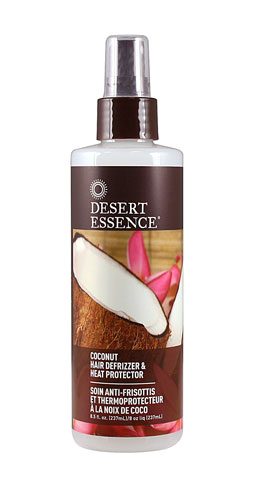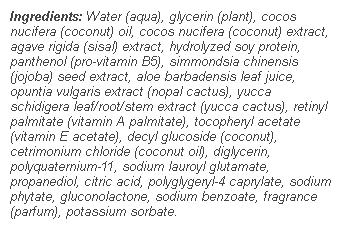| Glycerin | Emollient (Moisturizer) |
|---|
| Cocos nucifera | Contains Vitamin E and essential fatty acids |
|---|
| Agave rigida | This ingredient is currently being researched thoroughly by our team. A NutraWiki page summarizing our findings will be available soon. |
|---|
| Hydrolyzed soy protein | Soybeans grown with Organic Farming. The soybean is a species of legume native to East Asia, widely grown for its edible bean which has numerous uses. |
|---|
| Panthenol | Natural Conditioner |
|---|
| Simmondsia chinensis | In manufacturing, jojoba is used as an ingredient in shampoo; lipstick; makeup; cleansing products; and in face, hand, and body lotions. |
|---|
| Aloe barbadensis leaf juice | Aloe Barbadensis leaf juice, or Aloe Vera as it is more commonly known, is extracted from the leaves of the plant Aloe. |
|---|
| Opuntia vulgaris | This ingredient is currently being researched thoroughly by our team. A NutraWiki page summarizing our findings will be available soon. |
|---|
| Yucca schidigera | The fibers of the Yucca schidigera leaves were used by Native Americans to make rope, sandals, and cloth. The flowers and fruit could be eaten and the black seeds were ground into a flour. The roots were used to make soap. |
|---|
| Retinyl palmitate | Retinyl palmitate is a synthetic alternate for retinyl acetate in vitamin A supplements, and is available in oily or dry forms. |
|---|
| Tocopheryl acetate | Tocopheryl acetate is a fat-soluble vitamin that can be isolated from vegetable oils. It is also found in dairy products, meat, eggs, cereals, nuts, and leafy green and yellow vegetables. |
|---|
| Decyl glucoside | Decyl glucoside is a mild non-ionic surfactant used in cosmetic formularies including baby shampoo and in products for individuals with a sensitive skin |
|---|
| Cetrimonium chloride | Mainly used to prevent static and build-up in the hair. It can also cleanse the skin/hair and eliminate odor by preventing the growth of microorganisms, and by enabling water to mix with dirt and rinse it away. |
|---|
| Diglycerin | This ingredient is currently being researched thoroughly by our team. A NutraWiki page summarizing our findings will be available soon. |
|---|
| Polyquaternium-11 | This ingredient is currently being researched thoroughly by our team. A NutraWiki page summarizing our findings will be available soon. |
|---|
| Sodium lauroyl glutamate | It is used as a gentle cleanser that is suitable for sensitive skin. |
|---|
| Propanediol | It is produced on a large scale and is primarily used in the production of polymersbut also sees use in food processing as the E-number E1520. |
|---|
| Citric acid | Powerful Antioxidant - May Help Fight Cancer and Cardiovascular Diseases |
|---|
| Polyglygeryl-4 caprylate | This ingredient is currently being researched thoroughly by our team. A NutraWiki page summarizing our findings will be available soon. |
|---|
| Sodium phytate | Phytase is an enzyme that has the ability to liberate the phosphate and mineral residues from phytic acid (phytate), a compound formed during the maturation process of plant seeds and grains that is commonly found in plant-based foods. |
|---|
| Gluconolactone | Alpha hydroxy acids are a group of natural acids found in foods. Alpha hydroxy acids include citric acid (found in citrus fruits), glycolic acid (found in sugar cane), lactic acid (found in sour milk), malic acid (found in apples), tartaric acid (found in grapes), and others. |
|---|
| Sodium benzoate | A white, crystalline or granular, water-soluble powder, C 7 H 5 NaO 2, used chiefly as a food preservative and anti-fungal agent, and in diagnostic tests of liver function. |
|---|
| Fragrance | Appropriate for use on the human body |
|---|
| Potassium sorbate | Potassium sorbate’s use as an antimicrobial preservative prevents the growth of mold, bacteria and fungi in cheese, dried meats, baked goods, jellies and syrups. As a preservative in dried fruit, potassium sorbate often replaces sulfur dioxide, which has an aftertaste. The addition of potassium sorbate to dietary supplements inhibits microbes and increases shelf life. Many personal care products use potassium sorbate to prolong shelf stability and prevent bacteria contamination. Acting as a wine stabilizer, potassium sorbate prevents yeast from fermentation past the wine’s bottling stage. By inhibiting the fermentation process, it ceases production of yeast. |
|---|




Reviews
There are no reviews yet.